Moving electric charge
I can explain how an electric field causes electric current to flow in a circuit.
Moving electric charge
I can explain how an electric field causes electric current to flow in a circuit.
Link copied to clipboard
These resources will be removed by end of Summer Term 2025.
Switch to our new teaching resources now - designed by teachers and leading subject experts, and tested in classrooms.
These resources were created for remote use during the pandemic and are not designed for classroom teaching.
Lesson details
Key learning points
- Two unlike electric charges attract each other.
- Two like electric charges repel each other.
- In an electric circuit, electrons are forced towards the positive terminal of a battery.
- Electric current is the amount of charge that passes a point in a circuit in each second.
- Current can be found using the equation: current = charge ÷ time.
Keywords
Van de Graaff generator - A device that produces electric charge and is used in electrostatic experiments.
Charge - An electrical property; it can either be positive or negative.
Electric field - The invisible field around a charged object that causes another charged object to experience a force.
Coulomb - The unit of electric charge.
Ampere - The unit of electric current.
Common misconception
Magnetic field effects are often mistaken for electric field effects.
Be explicit in teaching that electric charges and charged objects are not magnetic.
To help you plan your year 10 combined science lesson on: Moving electric charge, download all teaching resources for free and adapt to suit your pupils' needs...
To help you plan your year 10 combined science lesson on: Moving electric charge, download all teaching resources for free and adapt to suit your pupils' needs.
The starter quiz will activate and check your pupils' prior knowledge, with versions available both with and without answers in PDF format.
We use learning cycles to break down learning into key concepts or ideas linked to the learning outcome. Each learning cycle features explanations with checks for understanding and practice tasks with feedback. All of this is found in our slide decks, ready for you to download and edit. The practice tasks are also available as printable worksheets and some lessons have additional materials with extra material you might need for teaching the lesson.
The assessment exit quiz will test your pupils' understanding of the key learning points.
Our video is a tool for planning, showing how other teachers might teach the lesson, offering helpful tips, modelled explanations and inspiration for your own delivery in the classroom. Plus, you can set it as homework or revision for pupils and keep their learning on track by sharing an online pupil version of this lesson.
Explore more key stage 4 combined science lessons from the Electric fields and circuit calculations unit, dive into the full secondary combined science curriculum, or learn more about lesson planning.

Equipment
Van de Graaff generator and discharge ball for demonstration.
Licence
Starter quiz
6 Questions



